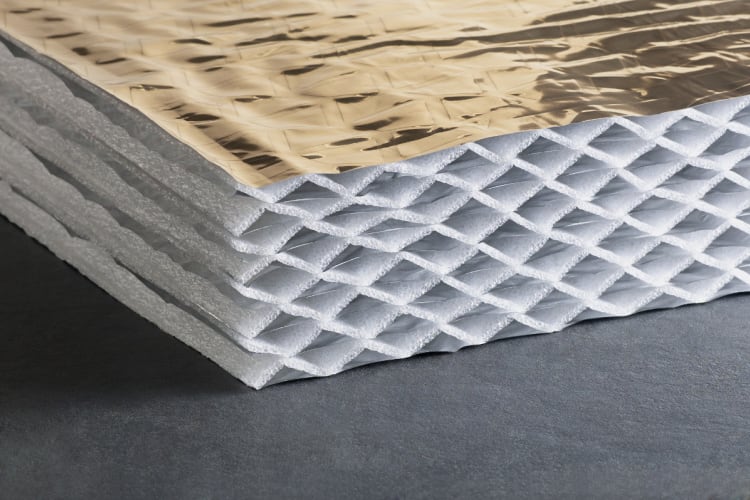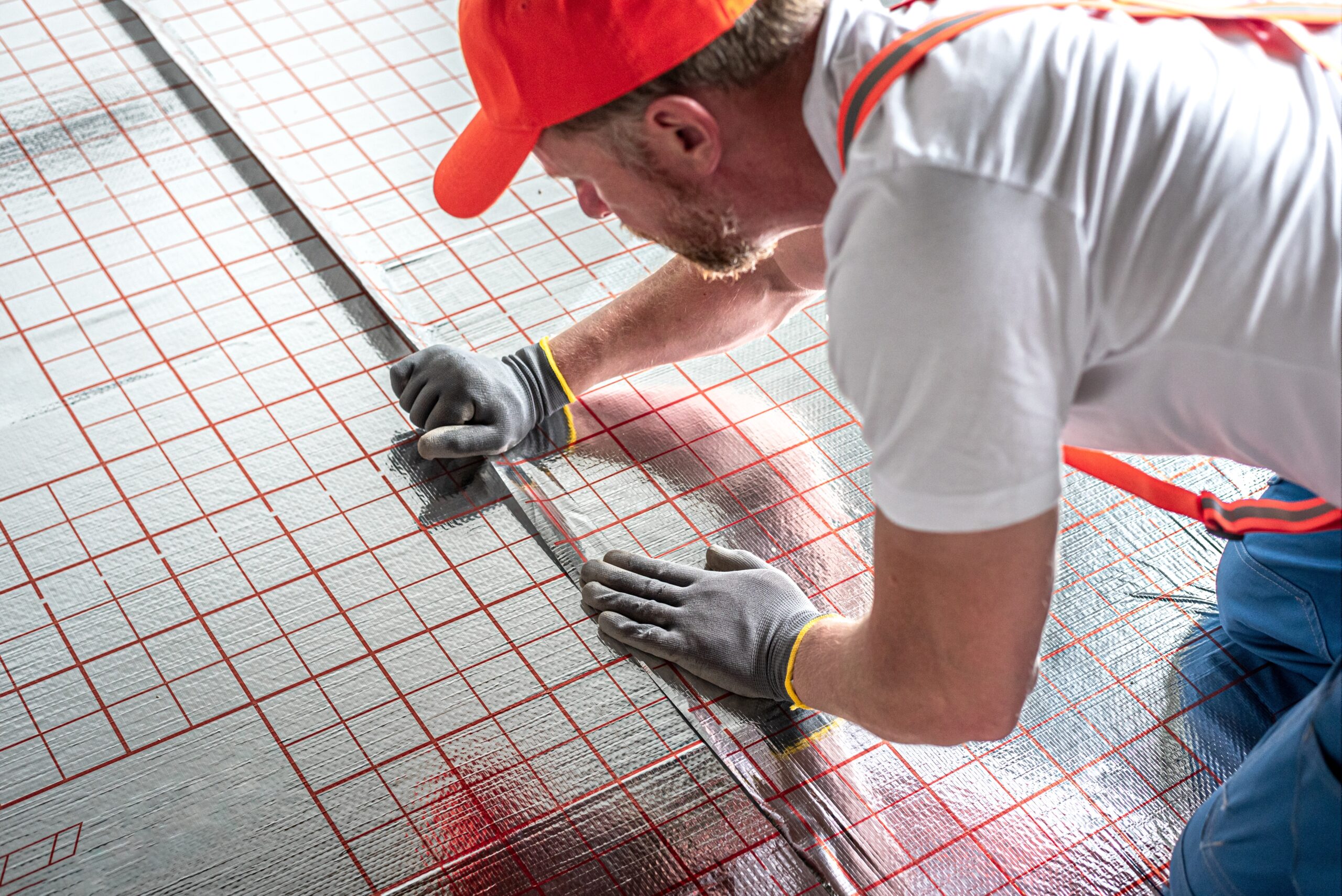Multifoil Insulation
(13 Products)Multifoil (sometimes called 'reflective foil' or 'radiant-barrier quilt') is a roll of many thin layers: shiny aluminium-finished films alternating with wadding or foam spacers. Together they’re roughly 40-45 mm thick (about the depth of two £1 coins stacked edge-to-edge) and they’re light enough to sling over your shoulder.
What Is Multifoil Insulation?
Multifoil is a quilt of many thin layers - shiny aluminium films alternated with soft spacers such as polypropylene wadding or light foam. The reflective faces bounce radiant heat back toward the living space, while the air pockets between layers slow down heat flow by conduction and convection.
Because the whole sandwich is only a few centimetres thick, it’s popular where every millimetre counts: loft conversions, timber-frame walls, and retrofits under floors or rafters.
Paired with conventional boards or batts, it adds airtightness, resists summer overheating, and keeps build-ups slim, all in a roll that one person can carry and cut with a knife and stapler.
How It Works
Multi foil insulation products target the three primary mechanisms that facilitate heat transfer; radiation, conduction and convection.
The low-emissivity reflective layers within multifoil function as an airtight barrier, reducing the chance of condensation in your build.
These surfaces reflect heat back into your project in winter while also controlling the amount of solar radiation entering the building in summer to make for a cooler, more comfortable living environment.
The layers of wadding between these reflective surfaces serve to trap air; this is how multifoil rolls prevent conduction.
Each roll has either a fibrous core (which reduces heat loss through convection and conduction) or a bubble-like structure (which contains pockets of air that reduce heat transfer).
Applications
- Pitched roofs
- Flat roofs
- Lofts
- Walls
- Floors
Multifoil may be applied internally as a vapour control layer to prevent heat loss or externally as a breathable membrane to avoid moisture accumulation.
Benefits
- Space-saving: Thin build-up compared to bulky mineral wool or rigid foam - ideal where depth is tight.
- Reflects radiant heat: Foil layers bounce warmth back into the room in winter and reflect excess heat out in summer.
- Improves airtightness: When taped well, it doubles as a vapour control layer, helping reduce drafts and heat loss.
- Quick and clean to install: No special tools needed - cut with a knife, staple into place. Minimal mess, no itchy fibres.
- Lightweight and flexible: Easy to carry, easy to shape around pipes, rafters, or awkward corners.
- Works well in hybrid systems: Pairs neatly with PIR boards or mineral wool to hit modern U-values while keeping thickness down.
- Suitable for roofs, walls, and floors: Especially useful in lofts, dormers, timber frames, and underfloor upgrades.
- Reduces condensation risk: Acts as a vapour barrier when installed with sealed overlaps, helping manage moisture.
- No sagging over time: Doesn’t slump like some fibrous products; holds its shape when correctly fixed.
Actis Multifoil Insulation
Actis specialises in manufacturing tailor-made insulation solutions for common insulation problems such as thermal bridging.
Actis Boost R Hybrid is designed for installation on the cold side of roofs. It is comprised of a breather membrane and reflective foil. This multifoil roof insulation also has a vapour control layer, meaning it acts as an air-tight vapour barrier, working to repel rot or fungus that would otherwise affect its longevity.
Actis Hcontrol, Isodhesif Tape, and Actis Hybris are other popular ranges from the same manufacturer. Within a single product, Hybris delivers two separate functions: vapour control and insulation. Actis Hybris panels are ideal for new build or retrofit insulation needs.
SuperFOIL Multifoil Insulation
SuperFOIL is best known for creating high-performance 3-in-1 silver multifoil insulation. Like the other high performance foil insulation products in our range, SuperFoil SF19+ is manufactured with thermal efficiency in mind.
SF19 roll contains a radiant barrier and a vapour control layer. Its radiant reflective properties control the temperature of your home throughout the year, reducing the amount of hot air that infiltrates your home in the summer and preventing heat loss in winter.
All SuperFoil SF19+ products are manufactured with 40% recycled materials, meaning they're as gentle on the environment as they are tough on thermal performance.
In most cases, SF19 rolls are installed over and under rafters and studs in lofts, although they are also certified for use in walls. SuperFOIL can also accommodate both flat and pitched roofs as well as single or multiple layers, making it a versatile option for a variety of applications.
SuperFOIL is relatively easy to install as it requires no specialist tools when installing.
SF19BB and SuperCLOSE are also part of the SuperFOIL range.
Frequently Asked Multifoil Insulation Questions
Is Multifoil Insulation Fireproof?
Not all multifoil rolls are fireproof. All insulation materials have a classification on the Euroclass scale. Materials undergo up to five tests to get a classification from A1 (non-combustible) to F (combustible).
Most insulation products, especially those that are composed of lots of different materials like multifoil roof insulation, land somewhere in the middle of the scale.
SuperFOIL SF19+ rolls have a Euroclass rating of E when they are placed behind plasterboard. Some multi foil rolls do not have a Euroclass rating, because they are designed for use in a build-up of materials rather than on their own.
Does Foil Insulation Cause Condensation?
Foil insulation is like a barrier that stops warm air from getting into a space. Condensation happens when hot air meets cold air and tiny drops of water form.
Foil insulation works by bouncing the warm air away, so the mix of hot and cold air can't make those water droplets. It helps keep things dry and comfy inside.
How Does Multi Foil Insulation Compare To Traditional Insulation Products?
Foil insulation is a crucial component when meeting building regulations for domestic, commercial, and industrial structures.
Whilst rigid board and fibre insulation are effective in reducing heat loss, multifoil insulation goes a step beyond by simultaneously managing airflow and water vapour. By combining heat, air, and moisture management in one product, multifoils make meeting building regulations an easy task.
The issue with rigid insulation is that it absorbs heat energy instead of reflecting it back into the space like multifoil insulation products do. Generally, rigid insulation such as Celotex and Kingspan only starts working to equalise a room's temperature once the board itself reaches that temperature.
Traditional insulation such as loft roll can take up room that you may not have. Multifoil insulation promises thin rolls with optimal thermal resistance. Most rolls are between 35-45mm, which is considered to be a good level. PIR, on the other hand, requires a greater thickness to meet current building regulations.
Multi foil insulation can also be installed alongside a build-up of other materials to improve the overall U-Value. The rolls are so thin that they can slot in alongside existing build-ups.
Many people choose these rolls when they want to improve their existing insulation without removing the entire build-up and starting from scratch.
Is Multifoil Insulation Effective In All Climates?
Multifoil insulation is effective in most climates. It is particularly beneficial in regions with temperature variations because it helps maintain a more stable indoor temperature.
However, its performance may vary depending on the specific climate and installation method.

.jpg)

.jpg)

.jpg)

.jpg)



